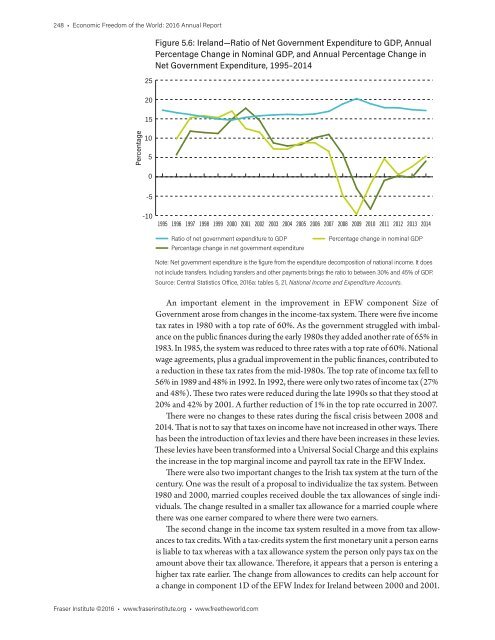Economic Freedom of the World
economic-freedom-of-the-world-2016
economic-freedom-of-the-world-2016
You also want an ePaper? Increase the reach of your titles
YUMPU automatically turns print PDFs into web optimized ePapers that Google loves.
248 • <strong>Economic</strong> <strong>Freedom</strong> <strong>of</strong> <strong>the</strong> <strong>World</strong>: 2016 Annual Report<br />
25<br />
20<br />
15<br />
Figure 5.6: Ireland—Ratio <strong>of</strong> Net Government Expenditure to GDP, Annual<br />
Percentage Change in Nominal GDP, and Annual Percentage Change in<br />
Net Government Expenditure, 1995–2014<br />
Percentage<br />
10<br />
5<br />
0<br />
-5<br />
-10<br />
1995<br />
1996<br />
1997<br />
1998<br />
1999<br />
2000<br />
2001<br />
2002<br />
2003<br />
2004<br />
2005<br />
2006<br />
2007<br />
2008<br />
2009<br />
2010<br />
2011<br />
2012<br />
2013<br />
2014<br />
Ratio <strong>of</strong> net government expenditure to GDP<br />
Percentage change in net government expenditure<br />
Percentage change in nominal GDP<br />
Note: Net government expenditure is <strong>the</strong> figure from <strong>the</strong> expenditure decomposition <strong>of</strong> national income. It does<br />
not include transfers. Including transfers and o<strong>the</strong>r payments brings <strong>the</strong> ratio to between 30% and 45% <strong>of</strong> GDP.<br />
Source: Central Statistics Office, 2016a: tables 5, 21, National Income and Expenditure Accounts.<br />
An important element in <strong>the</strong> improvement in EFW component Size <strong>of</strong><br />
Government arose from changes in <strong>the</strong> income-tax system. There were five income<br />
tax rates in 1980 with a top rate <strong>of</strong> 60%. As <strong>the</strong> government struggled with imbalance<br />
on <strong>the</strong> public finances during <strong>the</strong> early 1980s <strong>the</strong>y added ano<strong>the</strong>r rate <strong>of</strong> 65% in<br />
1983. In 1985, <strong>the</strong> system was reduced to three rates with a top rate <strong>of</strong> 60%. National<br />
wage agreements, plus a gradual improvement in <strong>the</strong> public finances, contributed to<br />
a reduction in <strong>the</strong>se tax rates from <strong>the</strong> mid-1980s. The top rate <strong>of</strong> income tax fell to<br />
56% in 1989 and 48% in 1992. In 1992, <strong>the</strong>re were only two rates <strong>of</strong> income tax (27%<br />
and 48%). These two rates were reduced during <strong>the</strong> late 1990s so that <strong>the</strong>y stood at<br />
20% and 42% by 2001. A fur<strong>the</strong>r reduction <strong>of</strong> 1% in <strong>the</strong> top rate occurred in 2007.<br />
There were no changes to <strong>the</strong>se rates during <strong>the</strong> fiscal crisis between 2008 and<br />
2014. That is not to say that taxes on income have not increased in o<strong>the</strong>r ways. There<br />
has been <strong>the</strong> introduction <strong>of</strong> tax levies and <strong>the</strong>re have been increases in <strong>the</strong>se levies.<br />
These levies have been transformed into a Universal Social Charge and this explains<br />
<strong>the</strong> increase in <strong>the</strong> top marginal income and payroll tax rate in <strong>the</strong> EFW Index.<br />
There were also two important changes to <strong>the</strong> Irish tax system at <strong>the</strong> turn <strong>of</strong> <strong>the</strong><br />
century. One was <strong>the</strong> result <strong>of</strong> a proposal to individualize <strong>the</strong> tax system. Between<br />
1980 and 2000, married couples received double <strong>the</strong> tax allowances <strong>of</strong> single individuals.<br />
The change resulted in a smaller tax allowance for a married couple where<br />
<strong>the</strong>re was one earner compared to where <strong>the</strong>re were two earners.<br />
The second change in <strong>the</strong> income tax system resulted in a move from tax allowances<br />
to tax credits. With a tax-credits system <strong>the</strong> first monetary unit a person earns<br />
is liable to tax whereas with a tax allowance system <strong>the</strong> person only pays tax on <strong>the</strong><br />
amount above <strong>the</strong>ir tax allowance. Therefore, it appears that a person is entering a<br />
higher tax rate earlier. The change from allowances to credits can help account for<br />
a change in component 1D <strong>of</strong> <strong>the</strong> EFW Index for Ireland between 2000 and 2001.<br />
Fraser Institute ©2016 • www.fraserinstitute.org • www.free<strong>the</strong>world.com


